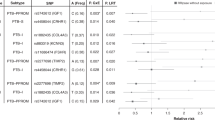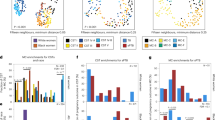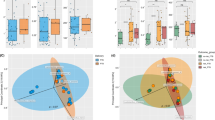Abstract
Background
The aim of this study was to determine the mediating effect of spontaneous preterm birth (PTB) main predictors that would allow to suggest etiological pathways.
Methods
We carried out a case–control study, including sociodemographic characteristics, habits, health care, and obstetric data of multiparous women who gave birth at a maternity hospital from Tucumán, Argentina, between 2005 and 2010: 998 women without previous PTB who delivered at term and 562 who delivered preterm. We selected factors with the greatest predictive power using a penalized logistic regression model. A data-driven Bayesian network including the selected factors was created where we identified pathways and performed mediation analyses.
Results
We identified three PTB pathways whose natural indirect effect was greater than zero with a 95% confidence interval: maternal age less than 20 years mediated by few prenatal visits, vaginal bleeding in the first trimester mediated by vaginal bleeding in the second trimester, and urinary tract infection mediated by vaginal bleeding in the second trimester. The effect mediated in these pathways showed greater sensitivity to confounders affecting the variables mediator–outcome and exposure–mediator in the same direction.
Conclusion
The identified pathways suggest PTB etiological lines related to social disparities and exposure to genitourinary tract infections.
Impact
-
Few prenatal visits (<5) and vaginal bleeding are two of the main predictors for spontaneous preterm birth in the studied population.
-
Few prenatal visits mediates part of the risk associated with maternal age less than 20 years and vaginal bleeding in the second trimester mediates part of the risk associated with vaginal bleeding in the first trimester and with urinary tract infection.
-
Social disparities and exposure to genitourinary tract infections would be etiological lines of spontaneous preterm birth.
Similar content being viewed by others
Log in or create a free account to read this content
Gain free access to this article, as well as selected content from this journal and more on nature.com
or
References
Chawanpaiboon, S. et al. Global, regional, and national estimates of levels of preterm birth in 2014: a systematic review and modelling analysis. Lancet Glob. Health 7, e37–e46 (2019).
Dirección de Estadísticas e Información de Salud—Ministerio de Salud de Argentina. Estadísticas vitales Información Básica 2018. (2019, accessed 17 February 2021); http://www.deis.msal.gov.ar/wp-content/uploads/2020/01/Serie5Nro62.pdf.
UNICEF, WHO, World Bank Group, United Nations. Levels and Trends in Child Mortality: Report 2019 (United Nations Children’s Fund, 2019).
Muglia, L. J. & Katz, M. The enigma of spontaneous preterm birth. N. Engl. J. Med. 362, 529–535 (2010).
Krupitzki, H. B. et al. Environmental risk factors and perinatal outcomes in preterm newborns, according to family recurrence of prematurity. Am. J. Perinatol. 30, 451–461 (2013).
Gimenez, L. G. et al. Maternal and neonatal epidemiological features in clinical subtypes of preterm birth. J. Matern. Fetal Neonatal Med. 29, 3153–3161 (2016).
Gimenez, L. G. et al. Association of candidate gene polymorphisms with clinical subtypes of preterm birth in a Latin American population. Pediatr. Res. 82, 554–559 (2017).
Koller, D. & Friedman, N. Probabilistic Graphical Models: Principles and Techniques (MIT Press, 2009).
Beresniak, A. et al. A Bayesian network approach to the study of historical epidemiological databases: modelling meningitis outbreaks in the Niger. Bull. World Health Organ. 90, 412–417A (2012).
Fuster-Parra, P. et al. Bayesian network modeling: a case study of an epidemiologic system analysis of cardiovascular risk. Comput. Methods Prog. Biomed. 126, 128–142 (2016).
Richiardi, L., Bellocco, R. & Zugna, D. Mediation analysis in epidemiology: methods, interpretation and bias. Int. J. Epidemiol. 42, 1511–1519 (2013).
Castilla, E. E. & Orioli, I. M. ECLAMC: the Latin-American collaborative study of congenital malformations. Community Genet. 7, 76–94 (2004).
Dietz, P. M. et al. A comparison of LMP‐based and ultrasound‐based estimates of gestational age using linked California livebirth and prenatal screening records. Paediatr. Perinat. Epidemiol. 21, 62–71 (2007).
Kuhn, M. Building predictive models in R using the caret package. J. Stat. Softw. 28, 1–26 (2008).
Friedman, J., Hastie, T. & Tibshirani, R. Regularization paths for generalized linear models via coordinate descent. J. Stat. Softw. 33, 1–22 (2010).
Firth, D. Bias reduction of maximum likelihood estimates. Biometrika 80, 27–38 (1993).
Heinze, G., Ploner, M., Dunkler, D. & Southworth, H. Package “logistf” (2020, accessed 17 February 2021); https://cran.r-project.org/web/packages/logistf/logistf.pdf.
Scutari, M., Graafland, C. E. & Gutiérrez, J. M. Who learns better Bayesian network structures: accuracy and speed of structure learning algorithms. Int. J. Approx. Reasoning 115, 235–253 (2019).
Heckerman, D., Geiger, D. & Chickering, D. M. Learning Bayesian networks: the combination of knowledge and statistical data. Mach. Learn. 20, 197–243 (1995).
Henrion, M. Propagating uncertainty in Bayesian networks by probabilistic logic sampling. Mach. Intell. Pattern Recognit. 5, 149–163 (1988).
Scutari, M. Learning Bayesian networks with the bnlearn R package. J. Stat. Softw. 35, 1–22 (2010).
Csardi, G. & Nepusz, T. The igraph software package for complex network research. InterJournal Complex Syst. 1695, 1–9 (2006).
Robins, J. M. & Greenland, S. Identifiability and exchangeability for direct and indirect effects. Epidemiology 3, 143–155 (1992).
Pearl, J. Direct and indirect effects. In: Proceedings of the Seventeenth Conference on Uncertainty in Artificial Intelligence, 2–5 August 2001 (Morgan Kaufmann Publishers Inc., 2001).
Lindmark, A., de Luna, X. & Eriksson, M. Sensitivity analysis for unobserved confounding of direct and indirect effects using uncertainty intervals. Stat. Med. 37, 1744–1762 (2018).
Yang, J. et al. Vaginal bleeding during pregnancy and preterm birth. Am. J. Epidemiol. 160, 118–125 (2004).
Hossain, R., Harris, T., Lohsoonthorn, V. & Williams, M. A. Risk of preterm delivery in relation to vaginal bleeding in early pregnancy. Eur. J. Obstet. Gynecol. Reprod. Biol. 135, 158–163 (2007).
Sharami, S. H. et al. The relationship between vaginal bleeding in the first and second trimester of pregnancy and preterm labor. Iran. J. Reprod. Med. 11, 385–390 (2013).
Murray, S. R., Stock, S. J., Cowan, S., Cooper, E. S. & Norman, J. E. Spontaneous preterm birth prevention in multiple pregnancy. Obstet. Gynaecol. 20, 57–63 (2018).
Wudie, F. T. et al. Determinants of preterm delivery in the central zone of Tigray, northern Ethiopia: a case-control study. South Afr. J. Child Health 13, 108–114 (2019).
Wehby, G. L., Murray, J. C., Castilla, E. E., Lopez-Camelo, J. S. & Ohsfeldt, R. L. Prenatal care effectiveness and utilization in Brazil. Health Policy Plan 24, 175–188 (2009).
Ratowiecki, J. et al. Inequidades sociales en madres adolescentes y la relación con resultados perinatales adversos en poblaciones sudamericanas. Cad. Saude Publica 36, e00247719 (2021).
Ketterlinus, R. D., Henderson, S. H. & Lamb, M. E. Maternal age, sociodemographics, prenatal health and behavior: influences on neonatal risk status. J. Adolesc. Health Care 11, 423–431 (1990).
Kalinderi, K., Delkos, D., Kalinderis, M., Athanasiadis, A. & Kalogiannidis, I. Urinary tract infection during pregnancy: current concepts on a common multifaceted problem. J. Obstet. Gynaecol. 38, 448–453 (2018).
Basso, O. & Baird, D. D. Infertility and preterm delivery, birthweight, and caesarean section: a study within the Danish National Birth Cohort. Hum. Reprod. 18, 2478–2484 (2003).
Konishi, S., Sakata, S., Watanabe, C. & Ng, C. F. S. Conception delay and spontaneous and indicated preterm birth among primiparous women in Japan. Jpn. J. Health Hum. Ecol. 84, 117–128 (2018).
Gimenes, F. et al. Male infertility: a public health issue caused by sexually transmitted pathogens. Nat. Rev. Urol. 11, 672 (2014).
Tsevat, D. G., Wiesenfeld, H. C., Parks, C. & Peipert, J. F. Sexually transmitted diseases and infertility. Am. J. Obstet. Gynecol. 216, 1–9 (2017).
Melamed, Y. et al. Differences in preterm delivery rates and outcomes in Jews and Bedouins in Southern Israel. Eur. J. Obstet. Gynecol. Reprod. Biol. 93, 41–46 (2000).
Eliyahu, S., Weiner, E., Nachum, Z. & Shalev, E. Epidemiologic risk factors for preterm delivery. Isr. Med. Assoc. J. 4, 1115–1117 (2002).
Dotters-Katz, S. K., Grotegut, C. A. & Heine, R. P. The effects of anemia on pregnancy outcome in patients with pyelonephritis. Infect. Dis. Obstet. Gynecol. 2013, 5 (2013).
Leifert, J. A. Anaemia and cigarette smoking. Int J. Lab. Hematol. 30, 177–184 (2008).
Stevens-Simon, C., Beach, R. K. & McGregor, J. A. Does incomplete growth and development predispose teenagers to preterm delivery? A template for research. J. Perinatol. 22, 315–323 (2002).
Wehby, G. L. & López-Camelo, J. S. Maternal education gradients in infant health in four South American countries. Matern Child Health J. 21, 2122–2131 (2017).
Zapata, M. E., Soruco, A. I. & Carmuega, E. Malnutrition in all its forms and socio-economic indicators in Argentina. Public Health Nutr. 23, s13–s20 (2020).
Axelsen, S. M., Henriksen, T. B., Hedegaard, M. & Secher, N. J. Characteristics of vaginal bleeding during pregnancy. Eur. J. Obstet. Gynecol. Reprod. Biol. 63, 131–134 (1995).
Elovitz, M. A., Baron, J. & Phillippe, M. The role of thrombin in preterm parturition. Am. J. Obstet. Gynecol. 185, 1059–1063 (2001).
Gómez, R. et al. Idiopathic vaginal bleeding during pregnancy as the only clinical manifestation of intrauterine infection. J. Matern Fetal Neonatal Med. 18, 31–37 (2005).
Nielson, E. C., Varner, M. W. & Scott, J. R. The outcome of pregnancies complicated by bleeding during the second trimester. Surg. Gynecol. Obstet. 173, 371–374 (1991).
Oyelese, Y. & Smulian, J. C. Placenta previa, placenta accreta, and vasa previa. Obstet. Gynecol. 107, 927–941 (2006).
Molina, P. E., Happel, K. I., Zhang, P., Kolls, J. K. & Nelson, S. Focus on: alcohol and the immune system. Alcohol Res. Health 33, 97 (2010).
Gonçalves, L. F., Chaiworapongsa, T. & Romero, R. Intrauterine infection and prematurity. Ment. Retard. Dev. Disabil. Res. Rev. 8, 3–13 (2002).
Rosen, T. et al. Thrombin-enhanced matrix metalloproteinase-1 expression: a mechanism linking placental abruption with premature rupture of the membranes. J. Matern. Fetal Neonatal Med. 11, 11–17 (2002).
Elias, D. et al. Preterm birth and genitourinary tract infections: assessing gene–environment interaction. Pediatr. Res. 1–7, https://doi.org/10.1038/s41390-020-01200-z (2020).
Vittinghoff, E. & McCulloch, C. E. Relaxing the rule of ten events per variable in logistic and Cox regression. Am. J. Epidemiol. 165, 710–718 (2007).
Acknowledgements
The authors want to thank Mrs. Mariana Piola and Alejandra Mariona. This work was supported by Agencia Nacional de Promoción Científica y Tecnológica (ANPCyT-MINCyT), PICT-2018-4275 to J.S.L.C. and PICT-2018-4285 to L.G.G., and Consejo Nacional de Investigaciones Científicas y Técnicas (CONICET).
Author information
Authors and Affiliations
Contributions
Each author has met the Pediatric Research authorship requirements. D.E. made substantial contributions to design, acquisition of data, analysis and interpretation of data, drafting the article, and approving the final manuscript as submitted. H.C., F.A.P., J.A.G., J.R., M.P., M.R.S., V.C., R.U., C.S., and M.R. made substantial contributions to design, acquisition of data, analysis and interpretation of data, and approving the final manuscript as submitted. S.L.H. made draft review and manuscript edition. H.B.K. and J.S.L.C. made substantial contributions to design, acquisition of data, critical manuscript revision for important intellectual content, and approving of the final version as submitted. L.G.G. made substantial contributions to design, acquisition of data, analysis and interpretation of data, drafting the article, and approving the final manuscript as submitted.
Corresponding author
Ethics declarations
Competing interests
The authors declare no competing interests.
Consent statement
Parents provided written informed consent for themselves and the neonates.
Additional information
Publisher’s note Springer Nature remains neutral with regard to jurisdictional claims in published maps and institutional affiliations.
Supplementary information
Rights and permissions
About this article
Cite this article
Elias, D., Campaña, H., Poletta, F.A. et al. Preterm birth etiological pathways: a Bayesian networks and mediation analysis approach. Pediatr Res 91, 1882–1889 (2022). https://doi.org/10.1038/s41390-021-01659-4
Received:
Revised:
Accepted:
Published:
Issue date:
DOI: https://doi.org/10.1038/s41390-021-01659-4
This article is cited by
-
Environmental and genetic risk factors for preterm birth: interplays with stressful events during pregnancy
Pediatric Research (2025)
-
Genetic susceptibility for retinopathy of prematurity and its associated comorbidities
Pediatric Research (2024)
-
Indirect Effects of Neighbourhood Socioeconomic Status on Preterm Birth Risk in an Argentine Population
Maternal and Child Health Journal (2024)
-
Technology-free predictors of preterm birth in singleton women with threatened preterm labor: a prospective cohort study
BMC Pregnancy and Childbirth (2022)
-
Genes, exposures, and interactions on preterm birth risk: an exploratory study in an Argentine population
Journal of Community Genetics (2022)



